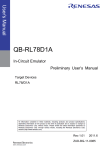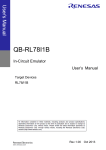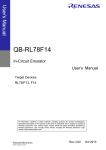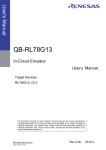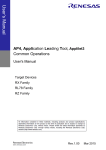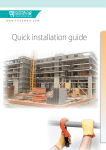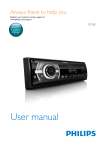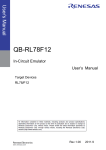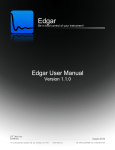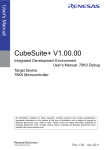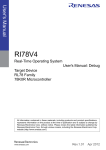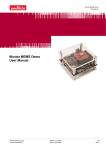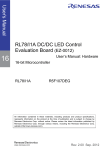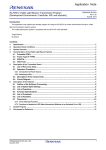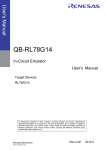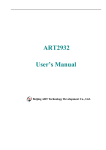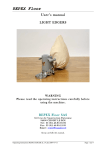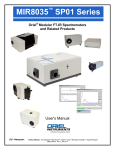Download QB-RL78D1A2 In-Circuit Emulator User`s Manual
Transcript
i8 QB-RL78D1A2 In-Circuit Emulator User’s Manual Target Devices R5F10DSL R5F10DPL R5F10DSK R5F10DPK R5F10DSJ Rev.1.01 Nov 2014 Notice 1. Descriptions of circuits, software and other related information in this document are provided only to illustrate the operation of semiconductor products and application examples. You are fully responsible for the incorporation of these circuits, software, and information in the design of your equipment. Renesas Electronics assumes no responsibility for any losses incurred by you or third parties arising from the use of these circuits, software, or information. 2. Renesas Electronics has used reasonable care in preparing the information included in this document, but Renesas Electronics does not warrant that such information is error free. Renesas Electronics assumes no liability whatsoever for any damages incurred by you resulting from errors in or omissions from the information included herein. 3. Renesas Electronics does not assume any liability for infringement of patents, copyrights, or other intellectual property rights of third parties by or arising from the use of Renesas Electronics products or technical information described in this document. No license, express, implied or otherwise, is granted hereby under any patents, copyrights or other intellectual property rights of Renesas Electronics or others. 4. You should not alter, modify, copy, or otherwise misappropriate any Renesas Electronics product, whether in whole or in part. Renesas Electronics assumes no responsibility for any losses incurred by you or third parties arising from such alteration, modification, copy or otherwise misappropriation of Renesas Electronics product. 5. Renesas Electronics products are classified according to the following two quality grades: “Standard” and “High Quality”. The recommended applications for each Renesas Electronics product depends on the product’s quality grade, as indicated below. “Standard”: Computers; office equipment; communications equipment; test and measurement equipment; audio and visual equipment; home electronic appliances; machine tools; personal electronic equipment; and industrial robots etc. “High Quality”: Transportation equipment (automobiles, trains, ships, etc.); traffic control systems; anti-disaster systems; anticrime systems; and safety equipment etc. Renesas Electronics products are neither intended nor authorized for use in products or systems that may pose a direct threat to human life or bodily injury (artificial life support devices or systems, surgical implantations etc.), or may cause serious property damages (nuclear reactor control systems, military equipment etc.). You must check the quality grade of each Renesas Electronics product before using it in a particular application. You may not use any Renesas Electronics product for any application for which it is not intended. Renesas Electronics shall not be in any way liable for any damages or losses incurred by you or third parties arising from the use of any Renesas Electronics product for which the product is not intended by Renesas Electronics. 6. You should use the Renesas Electronics products described in this document within the range specified by Renesas Electronics, especially with respect to the maximum rating, operating supply voltage range, movement power voltage range, heat radiation characteristics, installation and other product characteristics. Renesas Electronics shall have no liability for malfunctions or damages arising out of the use of Renesas Electronics products beyond such specified ranges. 7. Although Renesas Electronics endeavors to improve the quality and reliability of its products, semiconductor products have specific characteristics such as the occurrence of failure at a certain rate and malfunctions under certain use conditions. Further, Renesas Electronics products are not subject to radiation resistance design. Please be sure to implement safety measures to guard them against the possibility of physical injury, and injury or damage caused by fire in the event of the failure of a Renesas Electronics product, such as safety design for hardware and software including but not limited to redundancy, fire control and malfunction prevention, appropriate treatment for aging degradation or any other appropriate measures. Because the evaluation of microcomputer software alone is very difficult, please evaluate the safety of the final products or systems manufactured by you. 8. Please contact a Renesas Electronics sales office for details as to environmental matters such as the environmental compatibility of each Renesas Electronics product. Please use Renesas Electronics products in compliance with all applicable laws and regulations that regulate the inclusion or use of controlled substances, including without limitation, the EU RoHS Directive. Renesas Electronics assumes no liability for damages or losses occurring as a result of your noncompliance with applicable laws and regulations. 9. Renesas Electronics products and technology may not be used for or incorporated into any products or systems whose manufacture, use, or sale is prohibited under any applicable domestic or foreign laws or regulations. You should not use Renesas Electronics products or technology described in this document for any purpose relating to military applications or use by the military, including but not limited to the development of weapons of mass destruction. When exporting the Renesas Electronics products or technology described in this document, you should comply with the applicable export control laws and regulations and follow the procedures required by such laws and regulations. 10. It is the responsibility of the buyer or distributor of Renesas Electronics products, who distributes, disposes of, or otherwise places the product with a third party, to notify such third party in advance of the contents and conditions set forth in this document, Renesas Electronics assumes no responsibility for any losses incurred by you or third parties as a result of unauthorized use of Renesas Electronics products. 11. This document may not be reproduced or duplicated in any form, in whole or in part, without prior written consent of Renesas Electronics. 12. Please contact a Renesas Electronics sales office if you have any questions regarding the information contained in this document or Renesas Electronics products, or if you have any other inquiries. (Note 1) “Renesas Electronics” as used in this document means Renesas Electronics Corporation and also includes its majority-owned subsidiaries. (Note 2) “Renesas Electronics product(s)” means any product developed or manufactured by or for Renesas Electronics. (2012.4) General Precautions for Handling This Product 1. Circumstances not covered by product guarantee • If the product was disassembled, altered, or repaired by the customer • If it was dropped, broken, or given another strong shock • Use at overvoltage, use outside guaranteed temperature range, storing outside guaranteed temperature range • If power was turned on while connection to the AC adapter, USB interface cable, or target system was in an unsatisfactory state • If the cable of the AC adapter, the USB interface cable, the emulation probe, or the like was bent or pulled excessively • If an AC adapter other than the supplied product was used • If the product got wet • If this product is connected to the target system when there is a potential difference between the GND of this product and GND of the target system. • If the connectors or cables are plugged/unplugged while this product is in the power-on state. • If excessive load is applied to the connectors or sockets (As for handling, please see 2.3 Mounting and Connecting Connectors. • If a metal part of the power switch, cooling fan, or another such part comes in contact with an electrostatic charge. • If the product is used or stored in an environment where an electrostatic or electrical noise is likely to occur. 2. Safety precautions • If used for a long time, the product may become hot (50°C to 60°C). Be careful of low temperature burns and other dangers due to the product becoming hot. • Be careful of electrical shock. There is a danger of electrical shock if the product is used as described above in 1. Circumstances not covered by product guarantee. How to Use This Manual Readers This manual is intended for users who wish to perform debugging using the QBRL78D1A2. The readers of this manual are assumed to be familiar with the device functions and usage, and to have knowledge of debuggers. Purpose This manual is intended to give users an understanding of the basic specifications and correct usage of the QB-RL78D1A2. Organization This manual is divided into the following sections. • General • Setup procedure • Settings at product shipment • Cautions How to Read This Manual It is assumed that the readers of this manual have general knowledge in the fields of electrical engineering, logic circuits, and microcontrollers. This manual describes the basic setup procedures and how to set switches. To understand the overall functions and usages of the QB-RL78D1A2 → Read this manual in the order of the CONTENTS. To know the manipulations, command functions, and other software-related settings of the QB-RL78D1A2 → See the user’s manual of the debugger to be used. Conventions Note: Footnote for item marked with Note in the text Caution: Information requiring particular attention Remark: Supplementary information Numeric representation: Binary ... xxxx or xxxxB Decimal ... xxxx Hexadecimal ... xxxxH Prefix indicating power of 2 (address space, memory capacity): 10 K (kilo): 2 = 1,024 M (mega): 220 = 1,0242 Terminology The meanings of the terms used in this manual are described in the table below. Term Target device Target system Meaning This is the device to be emulated. This is the system to be debugged. This includes the target program and the hardware provided by the user. IECUBE TM Generic name for Renesas Electronics’ high-performance / compact In-circuit emulator. Related Documents Please use the following documents in conjunction with this manual. The related documents listed below may include preliminary versions. However, preliminary versions are not marked as such. Documents Related to Development Tools (User’s Manuals) Document Name Document Number QB-RL78D1A2 In-Circuit Emulator This manual RL78 family User’s Manual :Software R01US0015E Caution The related documents listed above are subject to change without notice. Be sure to use the latest version of each document for designing, etc. IECUBE is a registered trademark of Renesas Electronics Corporation in Japan and Germany. Windows is either registered trademarks or trademarks of Microsoft Corporation in the United States and/or other countries. PC/AT is a trademark of International Business Machines Corporation. CONTENTS CHAPTER 1 GENERAL ..................................................................................................................................... 7 1.1 Hardware Specifications ....................................................................................................................... 8 1.2 Names and Functions of Hardware ...................................................................................................... 9 1.3 System Specifications ......................................................................................................................... 11 1.4 System Configuration ......................................................................................................................... 12 1.5 System Configuration for Each Target Device ................................................................................... 14 1.6 Package Contents .............................................................................................................................. 15 1.7 AC Adapter for IECUBE...................................................................................................................... 16 CHAPTER 2 SETUP PROCEDURE ................................................................................................................ 17 2.1 Software Settings ................................................................................................................................ 18 2.2 Clock Settings ..................................................................................................................................... 18 2.3 Mounting and Connecting Connectors ............................................................................................... 22 2.3.1 Mounting NQ to target system .................................................................................................. 22 2.3.2 Mounting YQ to NQ .................................................................................................................. 23 2.3.3 Plugging EA into YQ ................................................................................................................. 23 2.3.4 Precautions for handling NQ, YQ, SA, and CA ........................................................................ 24 2.3.5 Precautions for mounting IC using NQ and MA ....................................................................... 25 2.4 Connecting QB-RL78D1A2 to Target System .................................................................................... 26 2.5 Notes on Power Supply and GND Pin Connection............................................................................. 29 2.6 Connecting USB Interface Cable and AC Adapter ............................................................................. 29 2.7 Switching Power On and Off............................................................................................................... 29 CHAPTER 3 SETTINGS AT PRODUCT SHIPMENT...................................................................................... 30 CHAPTER 4 CAUTIONS ............................................................................................................................... 31 4.1 Cautions Regarding Differences Between Target Device and QB-RL78D1A2 .................................. 31 4.2 Note of Debugging .............................................................................................................................. 34 APPENDIX A CHARCTERISTICS OF TARGET INTERFACE ...................................................................... 35 QB-RL78D1A2 In-Circuit Emulator CHAPTER 1 CHAPTER 1 GENERAL GENERAL The QB-RL78D1A2 is an in-circuit emulator for emulating “R5F10DSL, R5F10DSK, R5F10DSJ, R5F10DPL, R5F10DPK”. Hardware and software can be debugged efficiently in the development of systems in which “R5F10DSL, R5F10DSK, R5F10DSJ, R5F10DPL, R5F10DPK”used. This manual descries basic setup procedures, hardware specifications, system specifications, and how to set switches. R20UT3110EJ0101 Rev.1.01 Nov 28, 2014 Page 7 of 41 QB-RL78D1A2 In-Circuit Emulator 1.1 CHAPTER 1 GENERAL Hardware Specifications Table 1-1. QB-RL78D1A2 Hardware Specifications Parameter Specification Target device R5F10DSL,R5F10DSK,R5F10DSJ,R5F10DPL,R5F10DPK Operating voltage 2.4V to 5.5V Note7 Operating Main High-speed 2.7V ≤ VDD ≤ 5.5V:1~20 MHz frequency system system clock 2.4V ≤ VDD < 2.7 V:1~8 MHz clock Note1 oscillator High-speed 2.7V ≤ VDD ≤ 5.5V:4~32MHz on-chip oscillator 2.4V ≤ VDD < 2.7 V:4~24 MHz Low-speed on-chip oscillator 2.4 V ≤ VDD ≤ 5.5V: 15 KHz Subsystem clock oscillator Note2 2.4 V ≤ VDD ≤ 5.5V: 32.768 KHz 2.7 V ≤ VDD ≤ 5.5V: 32MHz PLL 2.4V ≤ VDD < 2.7 V:24 MHz Operating temperature range 0 to 40°C (No condensation) Storage temperature range −15 to 60°C (No condensation) External dimensions See figure below Power Current: approx. 55 mA MAX Target system power supply consumption Weight Approx. 400 g Host interface USB interface (1.1, 2.0) 108mm Note4 112mm Note3 67mm Rear space adapter Note5 Front space adapter Note6 Note1 Errors are within ±0.05%. However, this does not apply to errors of the oscillator or clock system on the target board. Note2 Errors are within ±0.004%. However, this does not apply to errors of the oscillator or clock system on the target board. Note3 Does not include projection of power switch Note4 Includes projection of screw that fixes rear space adapter Note5 Rear space adapter can adjust the height from 30 mm (longest) to 0 mm (shortest) Note6 Front space adapter can adjust the height from 20 mm (longest) to 5 mm (shortest) Note7 Use within voltage-range of the target device. R20UT3110EJ0101 Rev.1.01 Nov 28, 2014 Page 8 of 41 QB-RL78D1A2 In-Circuit Emulator 1.2 CHAPTER 1 GENERAL Names and Functions of Hardware Figure 1-1. Names of Parts of QB-RL78D1A2 Top View Bottom View TCN1 TCN2 TCN3 TCN4 CN6 OSC1 POWER (Red LED) TARGET (Green LED) Power switch Cooling fan R20UT3110EJ0101 Rev.1.01 Nov 28, 2014 Side View Power supply connector USB connector Page 9 of 41 QB-RL78D1A2 In-Circuit Emulator (1) CHAPTER 1 GENERAL TCN1, TCN2, TCN3 These are connectors for connecting a check pin adapter or emulation probe. (2) OSC1 This is a socket for mounting the oscillator. (3) CN6, TCN4 These are connectors for the shipment inspection. User does not need to use these connectors. (4) POWER (Red LED) This is an LED that shows whether the power supply of the QB-RL78D1A2 is switched on. LED State QB-RL78D1A2 State Lit Power switch ON Not lit Power switch OFF or AC adapter not connected to QB-RL78D1A2 Blinking Internal error occurred (Contact an Renesas Electronics sales representative or distributor) (5) TARGET (Green LED) This is an LED that shows whether the power supply of the target system is switched on. LED State (6) Target System State Lit Target system power supply ON Not lit Target system power supply OFF or target system not connected Power switch This is the power switch of the QB-RL78D1A2. It is OFF at shipment. (7) Cooling fun This is the cooling fun of the QB-RL78D1A2. It works when the power supply of the QB-RL78D1A2 is switched on. R20UT3110EJ0101 Rev.1.01 Nov 28, 2014 Page 10 of 41 QB-RL78D1A2 In-Circuit Emulator 1.3 CHAPTER 1 GENERAL System Specifications This section shows the QB-RL78D1A2 system specifications. Table 1-2. QB-RL78D1A2 System Specifications Parameter Emulation memory capacity Program execution functions Specification Internal ROM 512 KB (MAX.) Internal RAM 61.75 KB (MAX.) Real-time execution function Go, Start from Here, Come Here, Restart, Return Out, Ignore break points and Go Non-real-time execution function Step In, Next Over, Slow motion, Go & Go Memory manipulation Available (initialize, copy, compare) Register manipulation Available (general-purpose registers, control registers, SFRs) Disassemble function Available Local variable view Local variables Watch data view Local variables, global variables, or else Stack trace view Break functions Trace functions Available Event break Execution: 8 points Access: 8 points Software break 2000 points Pre-execution break 4 points Fail-safe break Non-map, write protect, SFR illegal access, stack overflow, or else Other Forcible break, trace full break, trace delay break, timeout break, timer overflow break Trace data types Program address, program data, access address, access data, status, time tag Trace modes Unconditional trace, section trace, qualify trace, delay trigger trace Trace functions Non-stop, full stop, full break, delay trigger stop, delay trigger break Memory capacity 128K frames Real-time RAM monitoring function All internal RAM spaces Time measurement functions Measurement clock 120 MHz Measurement objects Start through end of program execution Start event through end event Maximum measurement time Approx. 40 hours and 43 minutes Minimum resolution 8ns Number of timers for measurement Start through end of program execution: 1 Start event through end event: 2 Measurement results Execution time (start through end of execution) Maximum, minimum, average, total, pass count (between events) Other Other functions R20UT3110EJ0101 Rev.1.01 Nov 28, 2014 Timer overflow break function, timeout break function Command functions set in the console, mapping function, event function, coverage function, snapshot function, DMM function, power-off emulation function, pin mask function, flash selfprogramming emulation function Page 11 of 41 QB-RL78D1A2 In-Circuit Emulator 1.4 CHAPTER 1 GENERAL System Configuration This section shows the system configuration when using the QB-RL78D1A2 connected to a PC (WindowsTM PC, PC/AT TM compatible). Connection is possible even without optional products. Figure 1-2. System Configuration <1> <4> <2> <3> <5> <6> <7> < 11 > <8> < 12 > <9> < 10 > < 13 > <1> Host machine : Windows PC, IBM PC/AT compatible can be used <2> USB interface cable : Cable connecting QB-RL78D1A2 to host machine <3> AC adapter : AC adapters classified by region <4> QB-RL78D1A2 : This product <5> Check pin adapter (optional) : Adapter used for monitoring waveforms with oscilloscope <6> Emulation probe : High-characteristic FPC type emulation probe <7> Exchange adapter : Adapter that performs pin conversion <8> Space adapter (optional) : Adapter used for height adjustment <9> YQ connector : Connector that connects exchange adapter to target connector <10> Target connector : Connector soldered to target system <11> Mount adapter (optional) : Adapter used for mounting target device into socket <12> Device : Target device <13> Target system R20UT3110EJ0101 Rev.1.01 Nov 28, 2014 Page 12 of 41 QB-RL78D1A2 In-Circuit Emulator Remarks 1. Refer to 1.6 CHAPTER 1 GENERAL Package Contents for the purchase forms of the above products. 2. As for handling of connectors, refer to 2.3 Mounting and Connecting Connectors. 3. The part number of <3> differs depending on the region of use. See Table 1-5 Part Numbers of AC Adapter for IECUBE Classified by Region for the part numbers. The IECUBE requires an AC adapter that must be purchased separately. 4. See Table 1-4 Common Adapter and Probe for the part numbers of <5> and <6>. 5. The combination of <7>, <8>, <9>, <10>, and <11> varies depending on the emulation device. See Table 1-3 Adapters and Connectors for Each Target Device for the combinations. R20UT3110EJ0101 Rev.1.01 Nov 28, 2014 Page 13 of 41 QB-RL78D1A2 In-Circuit Emulator 1.5 CHAPTER 1 GENERAL System Configuration for Each Target Device The following table lists the system configuration for each target device of the QB-RL78D1A2. The adapter and connector for each device, and common probe and adapter are sold separately. Remark For the package drawings of the connector, adapter and probe, refer to the following URL. http://www.renesas.com/iecube/rl78 Table 1-3. Target Device Adapters and Connectors for Each Target Device Package Exchange Adaptor Space Adaptor YQ Connector Target Connector Mount Adaptor 100FB QB-100FB-EA-02T QB-100FB-YS-01T QB-100FB-YQ-01T QB-100FB-NQ-01T QB-100FB-HQ-01T 128FB QB-128FB-EA-02T QB-128FB-YS-01T QB-128FB-YQ-01T QB-128FB-NQ-01T QB-128FB-HQ-01T R5F10DPL, R5F10DPK R5F10DSL, R5F10DSK, R5F10DSJ Table 1-4. Name Common Adapter and Probe Part Number Target Device Check pin adapter QB-144-CA-01 RL78/D1A all products Emulation probe QB-144-EP-02S RL78/D1A all products R20UT3110EJ0101 Rev.1.01 Nov 28, 2014 Page 14 of 41 QB-RL78D1A2 In-Circuit Emulator 1.6 CHAPTER 1 GENERAL Package Contents The included products are described for each order product name. Products supplied with QB-RL78D1A2-ZZZ 1: QB-RL78D1A2 2: USB interface cable (2 meters) 3: Online user registration card (warranty card and software contract in one) 4: Probe holder 5: List of Package 6: Safety Precautions (IECUBE) information (document) 7: EMC regulation (FCC) (document) 8: Table of Toxic and Hazardous Substance and elements R20UT3110EJ0101 Rev.1.01 Nov 28, 2014 Page 15 of 41 QB-RL78D1A2 In-Circuit Emulator 1.7 CHAPTER 1 GENERAL AC Adapter for IECUBE The specifications of the AC adapter for IECUBE differ depending on the region of use. Be sure to use an AC adapter corresponding to the region of use. Table 1-5. Part Numbers of AC Adapter for IECUBE Classified by Region Product Destination (Region)Notes 1, 2 Part Number AC adapter Japan QB-COMMON-PW-JP (sold separately) USA QB-COMMON-PW-EA China QB-COMMON-PW-CN Hong Kong QB-COMMON-PW-HK Korea QB-COMMON-PW-KR Singapore QB-COMMON-PW-SG Taiwan QB-COMMON-PW-TW Notes 1. Products are shipped only on order from each region. 2. Contact a distributor or a Renesas Electronics sales representative for information on regions other than the above. R20UT3110EJ0101 Rev.1.01 Nov 28, 2014 Page 16 of 41 QB-RL78D1A2 In-Circuit Emulator CHAPTER 2 CHAPTER 2 SETUP PROCEDURE SETUP PROCEDURE This chapter explains the QB-RL78D1A2 setup procedure. Setup can be completed by performing installation setup in the order in which it appears in this chapter. Perform setup along the lines of the following procedure. See 1.2 Names and Functions of Hardware for clock positions. Software settings See 2.1 Software Settings. Clock settings See 2.2 Clock Settings. Mounting and connecting connectors See 2.3 Mounting and Connecting Connectors Connecting QB-RL78D1A2 to target system See 2.4 Connecting QB-RL78D1A2 to target system. Connecting USB interface cable and AC adapter See 2.6 Connecting USB interface cable and AC adapter. Switching power on and off See 2.7 Switching power on and off. R20UT3110EJ0101 Rev.1.01 Nov 28, 2014 Page 17 of 41 QB-RL78D1A2 In-Circuit Emulator 2.1 CHAPTER 2 SETUP PROCEDURE Software Settings Check the user's manual for the debugger that will be used. 2.2 Clock Settings The QB-RL78D1A2 clock must be set to the clock used by the target device. For details about how to set the clock, check the user's manual for the debugger that will be used. QB-RL78D1A2 clock settings for the clock used by the target device are shown below. Oscillation with the resonator on the target system is not supported. Therefore, the in-circuit emulator cannot emulate the oscillation operation of the clock on the target system. Table 2-1. List of clock settings Clock Used (1) High-speed system clock (X1 oscillator or External input) Clock Supply (a) When the clock generated within the emulator is used (b) When the clock (a square wave) is supplied from the target system (c) When the oscillator (OSC1) mounted onto the emulator is used (2) Internal high-speed Uses the clock internally generated from the emulator oscillation clock (3) Internal low-speed Uses the clock internally generated from the emulator oscillation clock (4) Subsystem clock (XT1 oscillator or External input) R20UT3110EJ0101 Rev.1.01 Nov 28, 2014 (a) When the clock generated within the emulator is used (b) When the clock (a square wave) is supplied from the target system Page 18 of 41 QB-RL78D1A2 In-Circuit Emulator CHAPTER 2 SETUP PROCEDURE (1) High-speed system clock The clock settings are listed below. Table 2-2. Settings for High-Speed System Clock Type of Clock to Be Used OSC1 (a) When the clock generated within the emulator is used (b) When the clock (a square wave) is supplied from the target system – Note (c) When the oscillator (OSC1) mounted onto the emulator is used – Oscillator mounted Note This setting is not possible when TARGET LED is not lit. Remarks 1. Settings other than the above are prohibited. 2. Selection of (a) or (b) is possible regardless of whether the oscillator is not mounted in the OSC1 socket. (a) When the clock generated within the emulator is used This method uses the clock generated inside the emulator. The oscillation frequency that will be used must be set in the debugger. For details about how to set the oscillation frequency, check the user's manual for the debugger that will be used. (b) When the clock (a square wave) is supplied from the target system The clock input from the target system is then used. To input a clock from the target system, input to the clock pin (X2) the square-wave signal with the same voltage potential as that of the target device supply voltage (VDD). Inputting the inverted signal to X1 is not necessary. The selectable frequencies are same as those of the target device. For debugger settings, check the user's manual for the debugger that will be used. Oscillation by a resonator in the target system is not supported. (c) When the oscillator (OSC1) mounted onto the emulator is used Mount an oscillator in the OSC1 socket in the emulator and then select the “Clock socket” in the debugger. The clock generated from the oscillator mounted on the emulator is used. The selectable frequencies are same as those of the target device. To modify the clock setting, the acrylic board on the bottom of the QB-RL78D1A2 must be removed. The acrylic board can be removed by lifting it up. For debugger settings, check the user's manual for the debugger that will be used. R20UT3110EJ0101 Rev.1.01 Nov 28, 2014 Page 19 of 41 QB-RL78D1A2 In-Circuit Emulator CHAPTER 2 SETUP PROCEDURE Figure 2-1. As an oscillator Note Acrylic Board Removal Method to be mounted in the OSC1 socket in the emulator, use the one that satisfies the following specifications. - Supply voltage: 5.0 V - Output level: CMOS Note An oscillation circuit that uses a resonator cannot be used. Figure 2-2. Oscillator Shape Top View Figure 2-3. Mapping of Oscillator to Socket Remark Insert the oscillator into the socket, take care for the pin 1 position. R20UT3110EJ0101 Rev.1.01 Nov 28, 2014 Page 20 of 41 QB-RL78D1A2 In-Circuit Emulator CHAPTER 2 SETUP PROCEDURE (2) Internal high-speed oscillation clock This method uses the clock inside the emulator by configuring the use of the high-speed oscillation clock in the user program. (3) Internal low-speed oscillation clock This method uses the clock inside the emulator by configuring the use of the low-speed oscillation clock in the user program. (4) Subsystem clock The clock settings are listed below. Table 2-3. Settings for Subsystem Clock Type of Clock to Be Used (a) When the clock generated within the emulator is used (b) When the clock (a square wave) is supplied from the target system (a) When the clock generated within the emulator is used This method uses the clock inside the emulator by configuring the use of the subsystem clock in the user program. For debugger settings, check the user's manual for the debugger that will be used. (b) When the clock (a square wave) is supplied from the target system The clock input from the target system is then used. To input a clock from the target system, input to the clock pin (XT2) the square-wave signal with the same voltage potential as that of the target device supply voltage (VDD). Inputting the inverted signal to XT1 is not necessary. The selectable frequencies are same as those of the target device. For debugger settings, check the user's manual for the debugger that will be used. Oscillation by a resonator in the target system is not supported. R20UT3110EJ0101 Rev.1.01 Nov 28, 2014 Page 21 of 41 QB-RL78D1A2 In-Circuit Emulator 2.3 CHAPTER 2 SETUP PROCEDURE Mounting and Connecting Connectors This section describes the methods of connecting the QB-RL78D1A2 and target system. Make connections with both the QB-RL78D1A2 and target system powered OFF. The following abbreviations are used in this section: - NQ: Target connector - YQ: YQ connector - EA: Exchange adapter - MA: Mount adapter - CA: Check pin adapter - SA: Space adapter 2.3.1 Mounting NQ to target system (1) Thinly apply a two-component epoxy adhesive (hardening time at least 30 minutes) to the ends of the four projections on the base of the NQ and adhere the NQ to the user board (clean the surface of the target system board using alcohol or the like). If alignment of target system pads to NQ leads is difficult, align them as in (2). (2) Align by inserting the guide pins for alignment for the NQ (NQGUIDE) through the pin holes on the top of the NQ. Accessory holes are φ1.0 mm non-through holes in two or three places. (For hole positions, see the particular NQ drawing.) (3) Solder after fitting the MA to the NQ. This is to prevent troubles such as flux or solder splashing and adhering to the NQ contact pins when soldering. - Soldering conditions Caution Solder reflow 260°C × 10 seconds or less Manual soldering 350°C × 5 seconds or less (1 pin) Do not perform washing by flux immersion or vapor. (4) Take away the guide pins. R20UT3110EJ0101 Rev.1.01 Nov 28, 2014 Page 22 of 41 QB-RL78D1A2 In-Circuit Emulator CHAPTER 2 SETUP PROCEDURE 2.3.2 Mounting YQ to NQ (1) After confirming that there are no broken or bent YQ contact pins, fit the YQ in the NQ and fasten it using the supplied YQGUIDE (for the fastening method, see the next step, (2)). be sure to inspect the YQ pins before fitting. If repeatedly inserting and removing, If pins are bent, correct them using something thin and flat such as the edge of a knife. (2) Fasten YQ to the NQ on the target system using the supplied YQGUIDE. Fasten the screws equally in the four corners using the supplied flat-blade screwdriver or a torque driver. The tightening torque of the YQGUIDE is 0.054 Nm (MAX.). Too great tightening causes bad connections. Four screws for fitting to the MA (M2 x 10 mm / 4 units) are also included with the YQ. Figure 2-4. Mounting of EA, YQ and NQ EA YQGUIDE supplied with YQ YQ NQ TC Target system 2.3.3 Plugging EA into YQ Match the pin 1 position of the YQ or SA (corner cuts match in both) to the pin 1 position of the EA and plug in. - When plugging or unplugging, press on the NQ, YQ, and SA with a finger so that there is no force on the NQ. - When plugging or unplugging, be careful of the direction of wiggling. As a tool when unplugging, insert some kind of thin non-conductive material such as a wooden stick between the YQ (SA) and EA and wiggle while slowly unplugging. Be careful since the connector will be damaged if this is done in the wrong direction. R20UT3110EJ0101 Rev.1.01 Nov 28, 2014 Page 23 of 41 QB-RL78D1A2 In-Circuit Emulator CHAPTER 2 SETUP PROCEDURE 2.3.4 Precautions for handling NQ, YQ, SA, and CA (1) When taking the NQ from the box, press down on the body and take out the sponge first. (2) Since the pins of the YQ are thin and easily bent, be careful. When inserting it in the NQ, confirm that there are no bent pins. (3) When screwing a YQ soldered to a board to the NQ, fasten the screws in four places in turn using a #0 or #1 Phillips precision screwdriver or torque driver after tentatively tightening them. Fix the torque at 0.054 Nm (MAX.). If just one place is over tightened, it may cause poor contact. Moreover, a board being connected to the YQ must have accessory holes in prescribed positions (four places: φ2.3 mm or φ3.3 mm). The φ3.8 mm or φ4.3 mm that is the screw head size is an area where wiring is prohibited. (4) In YQ and SA removal, since there is a possibility of YQ pins being bent or broken when prying and wiggling, remove them gradually using a flat-bladed screwdriver from four directions. Moreover, to connect and use the YQ and SA, screw the YQ to the NQ according to the YQGUIDE (included with the YQ) using a 2.3 mm flat-bladed screwdriver and then connect it to the SA. Fix the torque at 0.054 Nm (MAX.). If even one place is over tightened, it may cause poor contact. (5) For the NQ, YQ, and SA, since there is a possibility that washing fluid on the structure will remain in the connector, do not perform washing. (6) NQ, IC, and YQ cannot be used in combination. (7) A NQ/YQ system cannot be used in an environment of vibrations or shocks. (8) It is assumed that this product will be used in system development and evaluation. Moreover, when used in Japan, Electrical Appliance and Material Control Law and electromagnetic disturbance countermeasures have not been applied. (9) Since there are rare cases of shape change if the box is left for a long time in a place where it is 50°C or higher, for safekeeping, store it in a place where it is no higher than 40°C and direct sunlight does not hit it. (10) For details about handling the NQ, YQ, and SA, see the NQPACK series technical materials at the website of Tokyo Eletech Corporation. http://www.tetc.co.jp (11) CA The CA is an optional product for IECUBE, and can be used to measure the waveform between IECUBE and the target system. Since the pins on the CA do not correspond to the pin layout in each device, the pin header cover must be mounted according to the device to be used. For mounting methods of the pin header cover, refer to URL. http://www.renesas.com/qb_144_ca_01 R20UT3110EJ0101 Rev.1.01 Nov 28, 2014 Page 24 of 41 QB-RL78D1A2 In-Circuit Emulator CHAPTER 2 SETUP PROCEDURE 2.3.5 Precautions for mounting IC using NQ and MA (1) Confirm that there is no weld flash in the resin (sealant part) of the IC. If there is weld flash, remove it using a knife or the like. (2) Confirm that there is no weld flash breaking or bending of IC leads. leads. In particular, confirm the planarity of IC If there is abnormality in the planarity, correct that portion. (3) Viewing the NQ contact pins from the top, if there are foreign bodies on them, remove them using a brush or the like. After confirming (1) to (3), fit the IC to the NQ. Also fit the MA. (4) Put the supplied M2 x 6 mm screws in the four accessory holes of the MA and fasten the screws in opposite corners. At that time, use either the dedicated screwdriver that is supplied or a torque driver to fasten them equally in turn with a tightening torque of 0.054 Nm (MAX.). Since the contact is poor if tightening is too great, once you have lightly fastened the MA screws, tighten them again. (5) Depending on the use environment, when a device has been left for a long time, starting up may be late or not do. In this case, loosen the screws slightly and then retighten them. (6) If starting up may be late or not do after (5) above, check (1) to (3) again. (7) Tightening the screws of the MA too much may give rise to cracks in the molded part of the MA (plastic part) and bend the mold into a bowed shape, making contact poor. (8) After soldering the NQ, do not perform cleaning by flux immersion or vapor. R20UT3110EJ0101 Rev.1.01 Nov 28, 2014 Page 25 of 41 QB-RL78D1A2 In-Circuit Emulator 2.4 CHAPTER 2 SETUP PROCEDURE Connecting QB-RL78D1A2 to Target System If connecting the emulation probe (QB-144-EP-02S), connect it to the QB-RL78D1A2 and the target system by the following procedure. (a) Connect the QB-RL78D1A2 to the probe. Connect the emulation probe to the QB-RL78D1A2, as shown below. Insert CN1, CN2 and CN3 of the probe into TCN1, TCN2 and TCN3 of the QB-RL78D1A2. Insert the probe holder into QB-RL78D1A2 as below. Figure 2-5. Connect the QB-RL78D1A2 to the probe Probe holder (b) Connection of emulation probe GND wire There are three GND wires in the emulation probe. Connect them to the QB-RL78D1A2 and target system. <1> Fasten the GND wire on the QB-RL78D1A2 side of the emulation probe to the nut on the bottom of the QB-RL78D1A2 using a #0 or #1 Phillips precision screwdriver (connection of B to A in Figure 2-6). <2> Next insert the connector on the top of the emulation probe into the connector at the opening on the bottom of the QB-RL78D1A2 from below being careful of the insertion direction (connection of C in Figure 2-6 to QB-RL78D1A2). R20UT3110EJ0101 Rev.1.01 Nov 28, 2014 Page 26 of 41 QB-RL78D1A2 In-Circuit Emulator CHAPTER 2 SETUP PROCEDURE Figure 2-6. GND Wire QB-RL78D1A2 (A) (B) (C) (E) (F) (D) Target system (G) (H) <3> Connect the YQ connector and the exchange adapter to the target connector (D in Figure 2-6). <4> Connect the emulation probe to the exchange adapter (connection of E to F in Figure 2-6). <5> Connect the two GND wires on the target system side of the emulation probe to the target system GND. If a pin or screw is fastened to the target system GND, remove the transparent terminal cover on the end of the GND wire and fasten the Y terminal of the GND wire to the target system (G in Figure 2-6). If the GND on the target system is an exposed pad, likewise fasten the Y terminal to the pad on the target system by soldering (H in Figure 2-6) (recommended soldering iron temperature setting: 300°C). <6> If the target system has only one GND, connect only one of the GND wires of the emulation probe. Cut off the other GND wires with a nipper or leave it as is without removing the pin cover. <7> Since the length of the GND wire below the head (insulated part) is approximately 60 mm, there must be at least a GND to which it can be connected to within the range of the two approximately 60 mm radius sections of the target system for connecting the emulation probe, as shown in Figure 2-7. The GND wire of the emulation probe is soldered to positions J and K in Figure 2-7. R20UT3110EJ0101 Rev.1.01 Nov 28, 2014 Page 27 of 41 QB-RL78D1A2 In-Circuit Emulator CHAPTER 2 SETUP PROCEDURE Figure 2-7 Where GND Wire Can Be Connected L = 60 mm (J) 34.3 mm 24.7 mm (K) L = 60 mm User system (c) Ensuring isolation Adjust the height of the QB-RL78D1A2 with the front space adapter and the rear space adapter and ensure isolation from the target system. (d) Precautions related to emulation probe <1> Be careful that stress of the emulation probe is not placed on the target connector. Moreover, when removing the emulation probe, remove it slowly while pressing down on the exchange adapter with a finger so that there is no stress on the target connector. <2> Be sure to connect the GND wire of the emulation probe to the QB-RL78D1A2 and the target system. If it cannot be connected, the impedance of the cable is unstable and could bring about lowering of signal transmission characteristics or distortion of the output waveform for an input waveform. R20UT3110EJ0101 Rev.1.01 Nov 28, 2014 Page 28 of 41 QB-RL78D1A2 In-Circuit Emulator 2.5 CHAPTER 2 SETUP PROCEDURE Notes on Power Supply and GND Pin Connection For power supplies and GND pins of the target device, be sure to connect all pins to each power supply or GND. 2.6 Connecting USB Interface Cable and AC Adapter Plug the USB interface cable supplied with the QB-RL78D1A2 into the USB connector of the host machine, and plug the other side into the USB connector on the rear of the QB-RL78D1A2. Plug the AC adapter into the power supply connector on the rear of the QB-RL78D1A2 and plug the other side into a receptacle. For QB-RL78D1A2 connector positions, see Figure 2-8. Figure 2-8. Connector Positions Power supply connector (Connect AC adapter) USB connector (Connect USB interface cable) 2.7 Switching Power On and Off Be sure to switch the power on and off according to the following procedures. - Switching power on - Switching power off <1> QB-RL78D1A2 power on Note <1> Debugger termination <2> Target system power on <2> Target system power offNote <3> Debugger startup <3> QB-RL78D1A2 power off Note In the procedures, <2> is unnecessary if the target system is not connected. Caution If the wrong sequence was used for the operation, the target system or QB-RL78D1A2 may fail. R20UT3110EJ0101 Rev.1.01 Nov 28, 2014 Page 29 of 41 QB-RL78D1A2 In-Circuit Emulator CHAPTER 3 CHAPTER 3 SETTINGS AT PRODUCT SHIPMENT SETTINGS AT PRODUCT SHIPMENT Table 3-1. Item OSC1 Settings at Shipment Setting Not mounted Power switch Remarks Oscillator can be mounted Note . Set to OFF at shipment. Note The oscillation circuit using an oscillation cannot be used. R20UT3110EJ0101 Rev.1.01 Nov 28, 2014 Page 30 of 41 QB-RL78D1A2 In-Circuit Emulator CHAPTER 4 CHAPTER 4 4.1 CAUTIONS CAUTIONS Cautions Regarding Differences Between Target Device and QB-RL78D1A2 When debugging is performed by connecting the QB-RL78D1A2 to the target system, the QB-RL78D1A2 emulates the target device as if it operates in the target system. differently in the following ways. However, the target device and the QB-RL78D1A2 operate Consequently, the target device should be used for final evaluation before launching mass production, and the customer is to be responsible for judging the appropriateness of applying the QB-RL78D1A2. - On-chip debug function The on-chip debug function cannot be emulated. - Oscillator The QB-RL78D1A2 does not support clock input by an oscillator in the target system. Consequently, the operation clock frequency when the target device is mounted in the target system may differ from the operation clock frequency when the QB-RL78D1A2 is connected. - Pin characteristics The pin characteristics of the QB-RL78D1A2 slightly differ when the target device is mounted to the target system, because a connector, adapter, emulation probe, and circuit board exist between the QB-RL78D1A2 and the target system. In particular, note that the A/D converter conversion results are commonly-affected. - Current consumption The current consumption of the QB-RL78D1A2 differs from that of the target device. The maximum current consumption is around 55 mA. In the same manner, the current consumption in standby mode also differs from that of the target device. R20UT3110EJ0101 Rev.1.01 Nov 28, 2014 Page 31 of 41 QB-RL78D1A2 In-Circuit Emulator CHAPTER 4 CAUTIONS - Change the positive reference voltage on the A/D converter When change the positive reference voltage, after setting ADREFP1 and ADREFP0, stabilization wait time of emulator is different from that of the target device. Table 4-1 Target devices and stabilization wait time of QB-RL78D1A2 ADM2 register ( value after change ) ADREFP1 ADREFP0 stabilization wait time Target devices QB- RL78/D1A RL78D1A2 1 0 1μs 200μs 0 0 No 6μs 0 1 No 6μs - Characteristic of Target interface Please refer to APPENDIX A. - Power-on-reset (POR) voltage value The power-on-reset (POR) voltage value differs from that of the target device. Table 4-2. Item Target device QB-RL78D1A2 R20UT3110EJ0101 Rev.1.01 Nov 28, 2014 Power-on-reset (POR) voltage value MIN. TYP. MAX. POR 1.45 V 1.51 V 1.57V PDR 1.44 V 1.50 V 1.56V POR - 1.54 V - PDR - 1.47 V - Page 32 of 41 QB-RL78D1A2 In-Circuit Emulator CHAPTER 4 CAUTIONS - The detection voltage value of the voltage detector (LVD) LVD detection voltage differs from that of the target device. . Table 4-3. The detection voltage Target device RL78/D1A QB-RL78D1A2 Rising edge Failing edge Rising edge 2.50V 2.45V 2.46V 2.61V 2.55V 2.56V 2.71V 2.65V 2.66V 2.81V 2.75V 2.76V 2.92V 2.86V 2.87V 3.02V 2.96V 2.97V 3.13V 3.06V 3.07V 3.75V 3.67V 3.68V 4.06V 3.98V 3.99V Failing edge - PLL clock PLL is emulated by choosing fixed clock. The PLL input clock frequency (fPLLI) is only 0MHz, 4MHz, and 8MHz. The PLL output clock frequency (fPLL) become 1MHz if the combination between PLL input clock frequency and setting of PLLDIV is wrong. (e.g. fPLLI =4MHz PLLDIV =1 => fPLL :1MHz) - Pull-up There is a time lag (max 185ns) to work pull up register after setting PUx register. - LCD controller/driver behavior When executing STOP instruction or an instruction which stops the main system clock (fMAIN) with setting the main system clock (fMAIN) to an operation clock of LCD controller/driver, LCD controller/driver stops execution on target device. On the other hand, it continues execution on QB-RL78D1A2. - LCD There is a time lag (max 1ms) to change LCD waveform after the LCD function register setting. R20UT3110EJ0101 Rev.1.01 Nov 28, 2014 Page 33 of 41 QB-RL78D1A2 In-Circuit Emulator 4.2 CHAPTER 4 CAUTIONS Note of Debugging - Operation after target system power application After power application, a program will be executed for the target device mounted in the target system when reset is released. However, with the QB-RL78D1A2, the program does not start until an operation to start execution is performed after the program is downloaded using the debugger. - Relation between Standby function and Break function The break is interrupt function of CPU. The standby mode is released by the break for using the following debug function. - Forced break function. - Step execution of the standby instruction (Stops user program after executing instruction) - Pseudo real-time RAM monitor function (Break When Readout) - Pseudo Dynamic Memory Modification function (Break When Write) - Breakpoint setting during executing of the user program. - Invalid memory access detection function (IAW) The behavior when detecting an invalid memory access is different between target device and emulator. Target device : QB-RL78D1A2 : Reset Fail-safe break - CRC calculation function When using the CRC calculation function, do not set software breaks. Differing calculation results will be output. R20UT3110EJ0101 Rev.1.01 Nov 28, 2014 Page 34 of 41 QB-RL78D1A2 In-Circuit Emulator APPENDIX A APPENDIX A CHARCTERISTICS OF TARGET INTERFACE The target interface (signals connecting the in-circuit emulator and target system) operate, in terms of function, as if an actual device were connected. The characteristics, however, may be different from those of the actual device. QB-RL78D1A2 emulates the target interface by FPGA and some additional devices. The characteristics of target interface depend on their device characteristics. For the devices using in each target interface, please refer to the following. Figure A-1. R20UT3110EJ0101 Rev.1.01 Nov 28, 2014 Overview of QB-RL78D1A2 Block diagram Page 35 of 41 QB-RL78D1A2 In-Circuit Emulator APPENDIX A - Port Port function is emulated by FPGA and additional Level Shifter. Following devices are used. Level Shifter: UPD7886, SN74LVC1T45 QB-RL78D1A2 does not support the function of changing pin input mode by PIMx register. Table A-1. Characteristics of PORT PIN INPUT OUTPUT Etc. P122 SN74LVC1T45 - P122: Pull-Down(1M ohm) P80-P87,P90-P97 UPD7886 UPA679TB For Stepper Motor Others UPD7886 UPD7886 P124,RESET, P20-P27,P150-P152: Pull-Down(1M ohm) P137:Input only P130:output only - A/D Converter A/D Converter function is emulated by FPGA and additional ADC device. Following devices are used: ADC: ADC10664 Selector: PI5A4684 MUX: ADG706 OPAMP: AD8034 Figure A-2. R20UT3110EJ0101 Rev.1.01 Nov 28, 2014 A/D Block diagram Page 36 of 41 QB-RL78D1A2 In-Circuit Emulator APPENDIX A - POR/LVD POR/LVD function is emulated by FPGA and additional ICE Control chip. The ICE Control chip sense the target VDD with its AD converter. Following device is used: ICE Control chip: V850ES/SG3 Figure A-3. POR/LVD Block diagram - LCD Controller/Driver LCD function is emulated by FPGA and additional LCD driver. Following device is used: LCD driver: RL78/D1A (R5F10DSL :same as the target device) LCD function is emulated by following operation. Register setting of LCD are accepted by LCD Controller in the FPGA. LCD CTL write to the LCD register of R5F10DSL on IO board using parallel command interface between FPGA and R5F10DSL on IO board. R5F10DSL on IO board contains original program that receive the command from FPGA then write data to own register. There is a time lag to output LCD waveform outputs after setting LCD’s SFR. Clock cannot be stopped. Figure A-4. R20UT3110EJ0101 Rev.1.01 Nov 28, 2014 LCD Block diagram Page 37 of 41 QB-RL78D1A2 In-Circuit Emulator APPENDIX A - ZPD ZPD function is emulated by FPGA and additional CMP and DAC device. Following devices are used: Selector: PI5A4684 CMP: TC75W57FK DAC: AD7305BRUZ Figure A-5. ZPD Block diagram - Stepper Motor Controller/Driver Stepper-Motor function is emulated by FPGA and additional Level Shifter and MOSFET. Following devices are used: Selector: PI5A4684 MOSFET: UPA679TB Level Shifter: UPD7886,SN74LVC1T45 Figure A-6. R20UT3110EJ0101 Rev.1.01 Nov 28, 2014 Stepper Motor Block diagram Page 38 of 41 REVISION HISTORY QB-RL78D1A2 In-Circuit Emulator User’s Manual Rev. Date Description Page 1.00 1.01 Summary Oct 31, 2014 New. Nov 28, 2014 14 The order including attachments of an adapter and a probe was deleted. 15 QB-RL78D1A2 In-Circuit Emulator User’s Manual R20UT3110EJ0101









































